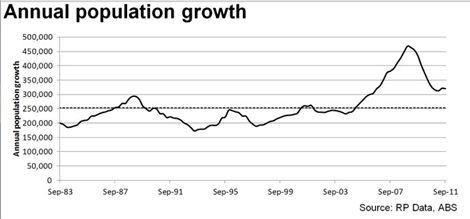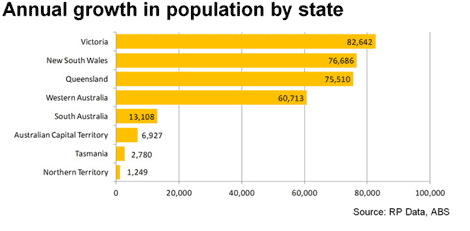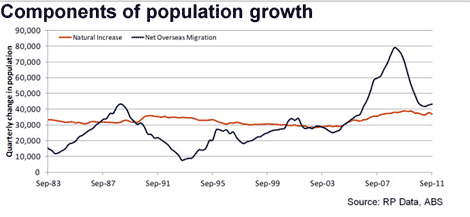Australia's population growth balancing act: RP Data's Cameron Kusher

The Australian Bureau of Statistics (ABS) recently released demographic data for September 2011 which showed that population growth has stabilised over the year after falling for much of the past three years.
Over the 12 months to September 2011, Australia’s population increased by almost 320,000 persons (319,632). This is an improvement compared to the recent low of 312,016 over the 12 months to March 2011, however, it is much lower than the peak of 467,314 over the 12 months to December 2008. On the first graph, the dotted line represents average population growth over the past 30 years and the current rate of growth remains well above average.
Click to enlarge Across the states, Victoria has recorded the greatest numerical increase in population with almost 83,000 new residents. Population growth in Victoria, New South Wales and Queensland has accounted for 73% of the nation’s growth in population over the past year.Click to enlarge
In percentage terms, Western Australia has been growing at a much faster rate than all other states and territories, increasing by 2.6% over the year. To put this into context, the Australian Capital Territory has been the second fastest growing region, with the population increasing by 1.9% over the year.
Over recent years, the slowdown in population growth has largely been the result of a targeted strategy to reduce overseas migration by the federal government.
Over the 12 months to September 2011 net overseas migration was 172,498 persons. Although this rate of migration is below the peaks of 315,686 persons over the 12 months to December 2008, the annual rate has been increasing over the past two quarters. Although the rate of net overseas migration has eased over the last few years it remains well above the long-term average (121,499).
Click to enlargeThe other component of population growth is natural increase (births minus deaths) and it remains quite high despite some recent easing. Over the year, around 147,000 more persons were born than those that had passed away. Natural increase has eased slightly in recent times after peaking at 155,082 persons over the year to September 2009 however, it still remains well above the long-term average levels of around 130,000.
Over the past 12 months, natural increase has accounted for 46% of population growth compared to 54% of population growth which was due to net overseas migration. Much more recent data on long-term arrivals and departures published by the ABS suggests that the rate of overseas migration is set to increase.
Over the 12 months the January 2012, the net annual long-term arrivals was recorded at 248,530 persons, and this figure has increased by 24.6% compared with January 2011. Given this increase, we would expect that net overseas migration will increase over the coming quarters and subsequently, population growth is also likely to increase at a faster rate.
The likelihood of higher rates of population growth are likely to provide some debate, especially considering that many expect the unemployment rate to increase over the coming year. Skilled overseas labour is important especially within the mining and resources sector where there are labour shortages.
Of course, higher population does bring some potential problems, as it increases the demand for housing, the need for infrastructure investment and demand for essential services. There are also environmental impacts of population growth with more demand for electricity and gas, building materials for homes and more pollution.
On the other hand, increases in population, particularly skilled working age population growth, increases the tax base and helps boost revenues for all levels of government. It also increases demand for goods and services across the economy.
Population growth is a balancing act and both sides of politics have argued that they don’t believe the record high rates of population growth recorded over 2007 and 2008 were appropriate. Given this, it will be interesting to see how much further the rate of net overseas migration increases over the coming quarters.
Cameron Kusher is senior research analyst at RP Data.
This article originally appeared on SmartCompany.


